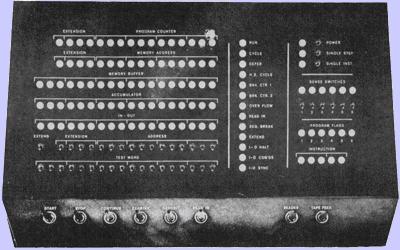Dec PDP 1

|
|
Dec PDP 1 |
 |
1959 |

| Caractéristiques techniques du PDP-1 |
|
Processeur 18 bits Mémoire : 4096 mots de 18 bits Entrée sortie de données : écran / clavier / cartes perforées Options : stylo optique, écran haute résolution, bandes magnétiques Logiciels fournis : Editeur, Assembleur et Debuggeur Prix : 120000 $ |


INTRODUCTION
The Programmed Data Processor (PDP-1) is a high speed, solid state digital computer designed
to operate with many types of input-output devices with no internal machine changes. It is a
single address, single instruction, stored program computer with powerful program features.
Five-megacycle circuits, a magnetic core memory and fully parallel processing make possible
a computation rate of 100,000 additions per second. The PDP-1 is unusually versatile. It is
easy to install, operate and maintain. Conventional 110-volt power is used, neither air
conditioning nor floor reinforcement is necessary, and preventive maintenance is provided
for by built-in marginal checking circuits.
PDP-1 circuits are based on the designs of DEC's highly successful and reliable System
Modules. Flip-flops and most switches use saturating transistors. Primary active elements
are Micro-Alloy-Diffused transistors.
The entire computer occupies only 17 square feet of floor space. It consists of four
equipment frames, one of which is used as the operating station.
CENTRAL PROCESSOR
The Central Processor contains the control, arithmetic and memory addressing elements, and
the memory buffer register. The word length is 18 binary digits. Instructions are performed
in multiples of the memory cycle time of five microseconds. Add, subtract, deposit, and
load, for example, are two-cycle instructions requiring 10 microseconds. Multiplication
requires and average of 20 microseconds. Program features include: single address
instructions, multiple step indirect addressing and logical arithmetic commands. Console
features include: flip-flop indicators grouped for convenient octal reading, six program
flags for automatic setting and computer sensing, and six sense switches for manual setting
and computer sensing.
MEMORY SYSTEM
The coincident-current, magnetic core memory of a standard PDP-1 holds 4096 words of 18 bits
each. Memory capacity may be readily expanded, in increments of 4096 words, to a maximum of
65,536 words. The read-rewrite time of the memory is five microseconds, the basic computer
rate. Driving currents are automatically adjusted to compensate for temperature variations
between 50 and 110 degrees Fahrenheit. The core memory storage may be supplemented by up to
24 magnetic tape transports.
INPUT-OUTPUT
PDP-1 is designed to operate a variety of buffered input-output devices. Standard equipment
consistes of a perforated tape reader with a read speed of 400 lines per second, and
alphanumeric typewriter for on-line operation in both input and output, and a perforated
tape punch (alphanumeric or binary) with a speed of 63 lines per second. A variety of
optional equipment is available, including the following:
Precision CRT Display Type 30
Ultra-Precision CRT Display Type 31
Symbol Generator Type 33
Light Pen Type 32
Oscilloscope Display Type 34
Card Punch Control Type 40-1
Card Reader and Control Type 421
Magnetic Tape Transport Type 50
Programmed Magnetic Tape Control Type 51
Automatic Magnetic Tape Control Type 52
Automatic Magnetic Tape Control Type 510
Parallel Drum Type 23
Automatic Line Printer and Control Type 64
18-bit Real Time Clock
18-bit Output Relay Buffer Type 140
Multiplexed A-D Converter Type 138/139
All in-out operations are performed through the In-Out Register or through the high speed
input-output channels.
The PDP-1 is also available with the optional Sequence Break System. This is a multi-channel
priority interrupt feature which permits concurrent operation of several in-out devices. A
one-channel Sequence Break System is included in the standard PDP-1. Optional Sequence Break
Systems consist of 16, 32, 64, 128, and 256 channels.
|